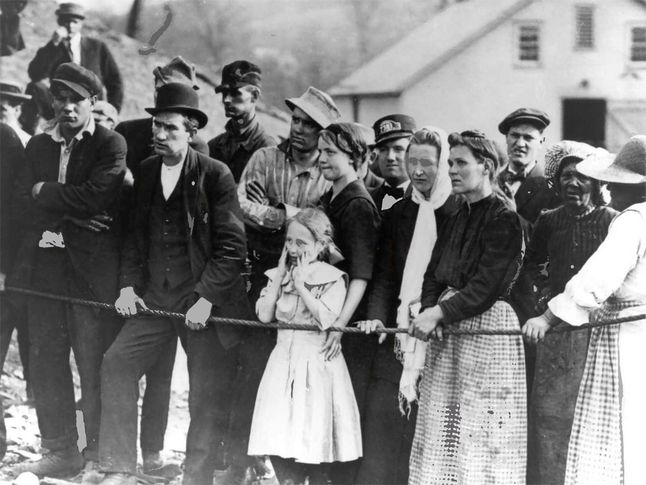This Day in Labor History: December 6, 1907

On December 6, 1907 the Monongah Mining Disaster in West Virginia killed at least 362 workers but probably over 500. This remains the most deadly mining disaster in American history.
Coal mining was a tremendously dangerous industry. It also required a lot of workers in a nation dependent on burning coal, both for industry and inside the home for heat. West Virginia was one of the centers of the coal industry and the coal companies treated the workers in this isolated Appalachian region like a medieval fiefdom. Not only would they have union organizers shot on sight, but they also did not care one whit when their workers died in the frequent explosions and fires that marred the industry.
This came to a crescendo on that dark day in 1907. The vast majority of the miners for the Fairmont Coal Company’s Mines 6 and 8 in Monongah were immigrants, mostly from Italy, some from Poland, Serbia, Russia, and Hungary. There were 362 known miners in the mine that day. Quite likely, there were at least 100 more–miners’ children who were helpers, mule drivers, and other low-end workers who did not officially check in with the company. It’s hard to say exactly what happened, especially given the questionable investigatory practices of the time. But we know that when the fire caught on fire, the resultant explosion destroyed all the ventilation shafts. So even if the workers did survive the initial blast, the rapidly rising blackdamp (carbon dioxide and nitrogen) and whitedamp (the same, plus carbon monoxide) would have suffocated them. It also made rescue operations impossible, as it would kill the rescuers too.
Ironically, these mines, which had only opened a few years before, had a reputation as among the state’s safest, partly because they were wired for electricity and thus did not require the carbide lamps that could often start fires. But the huge machines in these new mines created unprecedented levels of dust, which probably contributed to the fire and explosion.
A mining engineer who worked for Fairmont described it this way:
The heat left by the explosion was intense, and the stench from the decaying bodies of men and carcasses of horses and mules, with the necessarily poor ventilation, made the work at times almost unbearable…. All bodies of men employed on the main haulways had been blown to pieces…The entries in practically all cases showed evidence of extreme violence, one body being blown against the face of a heading with such force that it was mashed flat and left sticking to the coal…on this entry four bodies were found blown to pieces…the wreck of a motor and loaded trip was encountered; the motorman had been blown to pieces and parts of his body imbedded in the machinery. The brakeman was found along the entry, his arms, legs,and head blown off…on another heading pieces of a horse were scattered for a distance of 500 feet, torn so badly that the remains had to be gathered together with a shovel.
Only five miners escaped, four Italians and one Pole. Over 1,000 widows and partly or fully orphaned children resulted from this. A national relief effort raised $150,000 for these people to survive the winter, but of course poverty was the long-term reality for most of them. Every widow got $200 and every child $150, but the average annual wage for a miner was $643, so at best, with a few children, the money might last a year. The town basically became an open-air morgue as the bodies were slowly lifted out, or what was left of them. It was, by all accounts, incredibly gruesome. Of course, a postcard maker sold gruesome images of the scene. Always a market for tragedy in America.
This incident was hardly unique. The Avondale Colliery Fire in 1869 killed 110 miners in northeast Pennsylvania. Just a couple of weeks after Monongah, the Darr Fire in Pennsylvania killed 239 workers. In 1909, the Cherry Mine Fire killed 259 workers in Illinois. In December 1907 alone, more than 700 and perhaps up to 1,000 coal miners died in disasters in this West Virginia accident, as well the Darr and other horrible disasters in Alabama and New Mexico. This was the most deadly month in the history of American mining. In response to all of this, in 1910, Congress created the United States Bureau of Mines to work on mine safety. But while this was a step in the right direction, it did not have serious sticks to use against the mine companies and mine safety never received the priority it should have, all the way until Don Blankenship murdered 29 of his own miners through his open indifference to safety in 2010.
Many of the dead Italian miners came from the town of San Giovanni in Fiore, in Calabria. In 2003, they were honored in their home town with a plaque, naming them. And in 2007, the area of Molise, another place where a lot of the miners came from, gave the town of Monongah a bell to commemorate the centenary. It is in the town square today.
I borrowed from Brett Schmoll, “Masculine and Dead in the Mining Community: The Gendering of Death and the Monongah Mining Mine Explosion of 1907,” in a 2013 issue of Appalachian Studies to write this post. The long quote from the mining engineer is published in Joseph Louis Tropea’s 2017 article “Mutilation and Metaphor: Managing the Monongah Dead,” in the journal Culture and Organization.
This is the 339th post in this series. Previous posts are archived here.


